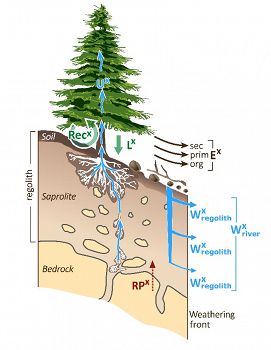Uhlig et al., 2017
Quantifying nutrient uptake as driver of rock weathering in forest ecosystems by magnesium stable isotopes
Uhlig, D., Schuessler, J.A., Bouchez, J., Dixon, J.L., von Blanckenburg, F. (2017)
Biogeosciences 14, 3111-3128
Abstract
Schematic figure illustrating the metrics used in Uhlig et al.'s flux model. See full article for abbreviation definitions.
Plants and soil microbiota play an active role in rock weathering and potentially couple weathering at depth with erosion at the soil surface. The nature of this coupling is still unresolved because we lacked means to quantify the passage of chemical elements from rock through higher plants. In a temperate forested landscape characterised by relatively fast (∼ 220 t km−2 yr−1) denudation and a kinetically limited weathering regime of the Southern Sierra Critical Zone Observatory (SSCZO), California, we measured magnesium (Mg) stable isotopes that are sensitive indicators of Mg utilisation by biota. We find that Mg is highly bio-utilised: 50–100 % of the Mg released by chemical weathering is taken up by forest trees. To estimate the tree uptake of other bio-utilised elements (K, Ca, P and Si) we compared the dissolved fluxes of these elements and Mg in rivers with their solubilisation fluxes from rock (rock dissolution flux minus secondary mineral formation flux). We find a deficit in the dissolved fluxes throughout, which we attribute to the nutrient uptake by forest trees. Therefore both the Mg isotopes and the flux comparison suggest that a substantial part of the major element weathering flux is consumed by the tree biomass. The enrichment of 26Mg over 24Mg in tree trunks relative to leaves suggests that tree trunks account for a substantial fraction of the net uptake of Mg. This isotopic and elemental compartment separation is prevented from obliteration (which would occur by Mg redissolution) by two potential effects. Either the mineral nutrients accumulate today in regrowing forest biomass after clear cutting, or they are exported in litter and coarse woody debris (CWD) such that they remain in solid biomass. Over pre-forest-management weathering timescales, this removal flux might have been in operation in the form of natural erosion of CWD. Regardless of the removal mechanism, our approach provides entirely novel means towards the direct quantification of biogenic uptake following weathering. We find that Mg and other nutrients and the plant-beneficial element Si (bio-elements) are taken up by trees at up to 6 m depth, and surface recycling of all bio-elements but P is minimal. Thus, in the watersheds of the SSCZO, the coupling between erosion and weathering might be established by bio-elements that are taken up by trees, are not recycled and are missing in the dissolved river flux due to erosion as CWD and as leaf-derived bio-opal for Si. We suggest that the partitioning of a biogenic weathering flux into eroded plant debris might represent a significant global contribution to element export after weathering in eroding mountain catchments that are characterised by a continuous supply of fresh mineral nutrients.
Citation
Uhlig, D., Schuessler, J.A., Bouchez, J., Dixon, J.L., von Blanckenburg, F. (2017): Quantifying nutrient uptake as driver of rock weathering in forest ecosystems by magnesium stable isotopes. Biogeosciences 14, 3111-3128. DOI: 10.5194/bg-14-3111-2017
 This Paper/Book acknowledges NSF CZO grant support.
This Paper/Book acknowledges NSF CZO grant support.
Explore Further

